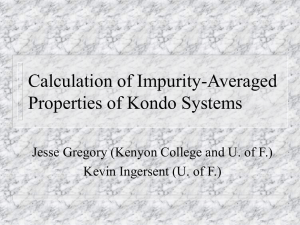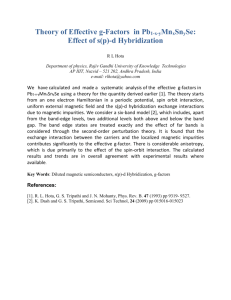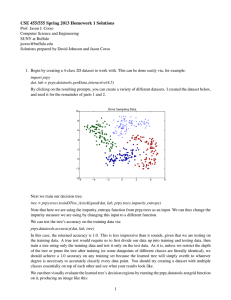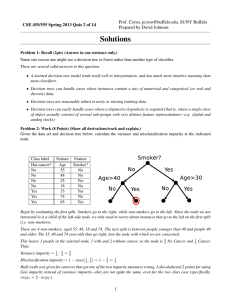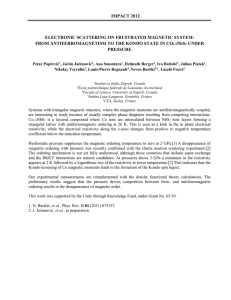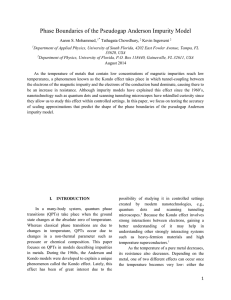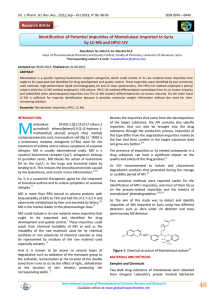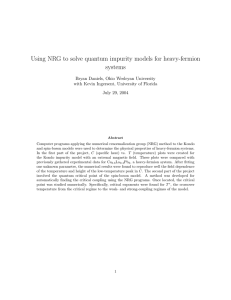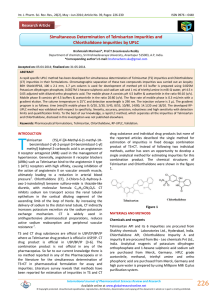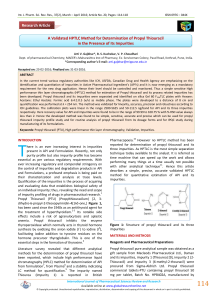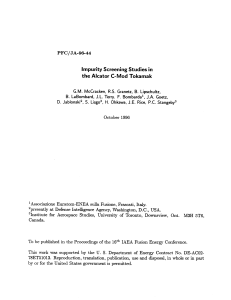Calculation of Impurity-Averaged Properties of Kondo Systems Jesse Gregory and Kevin Ingersent
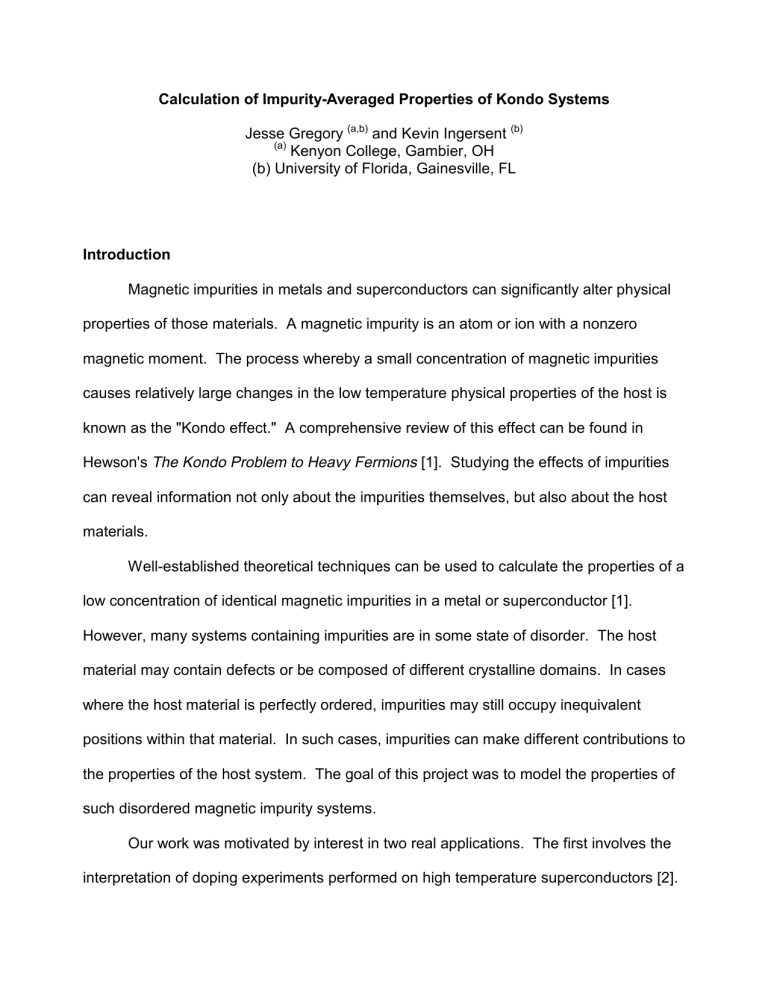
Introduction
Calculation of Impurity-Averaged Properties of Kondo Systems
Jesse Gregory
(a,b)
and Kevin Ingersent
(b)
(a)
Kenyon College, Gambier, OH
(b) University of Florida, Gainesville, FL
Magnetic impurities in metals and superconductors can significantly alter physical properties of those materials. A magnetic impurity is an atom or ion with a nonzero magnetic moment. The process whereby a small concentration of magnetic impurities causes relatively large changes in the low temperature physical properties of the host is known as the "Kondo effect." A comprehensive review of this effect can be found in
Hewson's The Kondo Problem to Heavy Fermions [1]. Studying the effects of impurities can reveal information not only about the impurities themselves, but also about the host materials.
Well-established theoretical techniques can be used to calculate the properties of a low concentration of identical magnetic impurities in a metal or superconductor [1].
However, many systems containing impurities are in some state of disorder. The host material may contain defects or be composed of different crystalline domains. In cases where the host material is perfectly ordered, impurities may still occupy inequivalent positions within that material. In such cases, impurities can make different contributions to the properties of the host system. The goal of this project was to model the properties of such disordered magnetic impurity systems.
Our work was motivated by interest in two real applications. The first involves the interpretation of doping experiments performed on high temperature superconductors [2].
In these materials, native copper atoms carry magnetic moments, which tend to orient themselves antiferromagnetically with respect to their neighbors. When a nonmagnetic atom is introduced, one obtains physical effects akin to those achieved by introducing a magnetic impurity into a nonmagnetic metal. Evidence concerning the nature of the superconductor can be found in the response to the introduced impurities. Modeling these systems is difficult, however, as significant disorder is usually present.
The second application of our work is to heavy-fermion systems. Heavy fermions are compounds containing (typically) Ce or U local moments, characterized by unusually large specific heat capacity values at low temperatures. In many cases, it is not possible to grow single crystals of these materials. Instead experiments are performed on polycrystalline samples which contain many small crystalline domains. When polycrystals are subjected to an external magnetic field, the field makes a different angle to the crystal axis of each domain. In order to model the magnetic response of polycrystalline heavy fermions, it is necessary to average over all crystal orientations.
For both applications described above, our goal was to be able to average the contributions of different impurities to find the overall physical properties of the system. It should be noted that we made no attempt to account for interactions between impurities.
Our approach should be valid in the limit of low concentrations, or in other situations where impurity interactions are known to be insignificant.
The Project
We focus on magnetic impurities that exhibit a spin 1/2. The Kondo model for such an impurity can be described by two parameters, J and V. (In this paper J and V will be
expressed in units of the conduction half-bandwidth.) These parameters enter the two terms that describe the interaction energy between the impurity and the host.
The first term for the interaction energy is
E
1
= J (S impurity
•
S electron
) where S impurity
is the inherent spin of the impurity, and S electron
is the spin of any conduction electron at the impurity site. The second term takes the form
E
2
= V (N electrons
- 1) where N electrons
is the number of conduction electrons at the impurity site. Due to the Pauli exclusion principle, N electrons
can only take the values 0, 1, or 2, meaning that E
2
= 0 or +/-
V. A combination of the two interaction terms yields the following expression for the total energy:
E total
= J (S impurity
•
S electron
) + V (N electrons
- 1).
The goal of this project was to produce theoretical curves of a physical property X, generally measured as a function of temperature T, for systems containing impurities whose parameters J and V are distributed according to some probability function P(J,V).
Besides this probability distribution, a second input is a series of data sets showing the temperature dependence of X for a single impurity of known J and V. To produce the output curves it is necessary to develop a procedure for interpolating X at arbitrary values of J and V from the input data sets, and then to perform the average
X(T) =
∫ dJ
∫ dV P(J,V) X(J,V,T).
We wrote a program in Fortran to perform these tasks. The program loops over a sequence of decreasing temperatures. At each temperature the program calls three main subroutines, which will be briefly outlined. The first subroutine is a data collation routine.
The inputted data sets contain a range of temperatures for a single J and V combination.
This first subroutine regroups the data into sets of varying J's and V's at a single temperature.
The second subroutine is an interpolation routine. The interpolation is performed by the NAG routine E01SAF [3]. From the known values of X at discrete J and V combinations, the NAG routine interpolates X for arbitrary J and V within a fixed range of
J's and a fixed range of V's. This interpolation function can be evaluated for arbitrary J and V using NAG routine E01SBF.
The final subroutine contained in the main loop of our program is an integration routine. The NAG routine D01DAF is used to perform the integral
X(T) =
∫ dJ
∫ dV P(J,V) X(J,V,T).
The E01SBF routine is used as the X(J,V,T) integrand. The P(J,V) integrand is a usersupplied function of J and V. The value of this integral represents the averaged impurity contribution for the given temperature T. For a copy of the program code please contact the author.
Results and Conclusion
In this report we focus on the magnetic susceptibility
χ
(T), calculated within a simple model of d-wave superconductors (such as the high temperature superconductors studied in Refs. 2). We assume a superconducting gap of width 10
-3
. (All energies and temperatures are expressed in terms of the conduction half bandwidth.) Inside the gap, the density of states varies linearly with energy (measured from the Fermi surface).
Outside the gap, the density of states does not change from its value at the gap edge.
The single-impurity calculations for each J and V combination were performed using the numerical renormalization group method [4]. For details of the calculations, see Ref. 5.
Our single-impurity data were calculated for points lying on a grid of J and V values. The grid included all combinations of J values taken from the set 0.05, 0.1, 0.2, 0.3, 0.4, 0.5, and 0.7, with V values chosen from 0.05, 0.1, 0.2, 0.3, 0.4, 0.5, and 0.7.
Figure 1 shows two sample single-impurity data sets used in the susceptibility calculations. The quantity plotted, T
χ
, is scaled so that a value of 1/4 represents a free spin-1/2. The Kondo effect involves the screening of the impurity spin by a nearly bound conduction electron. The signature of this screening is the approach of T
χ
to zero at very low temperatures.
In a conventional metal, any magnetic impurity described by the Kondo model (with
J > 0) is screened at sufficiently low temperatures. However, the situation in a superconductor is more complicated. There exists a V-dependent critical value of J, as show in Figure 2. A Kondo effect takes place only if J > J c
(V). For J < J c
the impurity becomes decoupled from the host at low temperatures. As a result, T
χ
tends to 1/4 in these cases. Figure 1 illustrates the full temperature dependence of T
χ
in these two regimes.
For illustrative purposes, we have employed three Gaussian probability functions
P(J,V) of increasing widths along the J and V directions (as listed in the caption to Figure
2). In addition, for reasons that will be explained below, we imposed a cutoff (shown in
Figure 2) beyond which we set P(J,V) to zero.
From Figure 1, it can be seen that the first probability distribution includes only J values exceeding J c
, whereas the middle probability distribution includes a small fraction
of subcritical J values. Subcritical J values constitute a larger portion of the widest probability distribution. For this reason, it is expected that the low-temperature limit of T
χ will increase with the width of the probability distribution.
Our results corroborate this prediction. Figure 3 shows the T
χ
curves obtained from the three probability distributions. As predicted, the low-temperature limit of T
χ increases as the distribution broadens. We can conclude that as subcritical J values constitute a larger portion of the contributing probability distribution, the low-temperature limit of T
χ
will eventually approach 1/4.
We should note one slight difficulty that arose during our trials. As discussed, there exist two possible trends in T
χ
curves as temperature approaches zero. When interpolating data sets with diverging trends, it is difficult to implement an accurate fit.
During some early tests, disruptions appeared in otherwise smooth curves, features that we attributed to interpolation difficulties. These problems were overcome by reducing the required accuracy in the evaluation of the integral and introducing the cutoff on the probability distributions. A less ad hoc remedy for this problem is desirable. One promising approach would involve the use of two distinct interpolations, one for values J >
J c
(V), and a second for values J < J c
(V). This change could be made without altering any other aspects of the program.
It should also be noted that our program is capable of modeling any property X, so long as we can provide single-impurity data for that property. While we focused on thermodynamic properties in this study, it would also be interesting to investigate transport
(electrical resistivity) and local properties (such as the local susceptibility measured in
NMR experiments [2]).
1. A. C. Hewson, The Kondo Problem to Heavy Fermions (Cambridge University Press,
Cambridge, 1993).
2. A.V. Mahajou, H. Alloul, G. Collin, and J.F. Marucco, Phys. Rev. Lett. 72, 3100 (1994);
J. Bobroff et al., Phys. Rev. Lett. 83, 4381 (1999); W. A. MacFarlane et al., preprint cond-mat / 9912165.
3. NAG Fortran 77 Library. See www.nag.com/numeric/FLOLCH.html
.
4. K. G. Wilson, Rev. Mod. Phys. 47, 773 (1975).
5. C. Gonzalez-Buxton and K. Ingersent, Phys. Rev. B 57, 14254 (1998).
FIG. 1. Single-impurity susceptibility T
χ
vs log
10
(T) for two values of J at fixed V.
FIG. 2. Probability distributions used in our calculations. Each distribution is a Gaussian centered on J = 0.5, V = 0.35. The widths of distributions 1, 2, and 3 along the (J, V) directions are (0.05, 0.07), (0.08, 0.1), and (0.13, 0.1), respectively. Contours show cutoffs beyond which each probability distribution was set to zero.
FIG. 3. Averaged impurity susceptibility T
χ
vs log
10
(T) for the three distributions shown in
Fig. 2.
